-
Sally Approaching SG601
Posted on September 13th, 2020 No commentsSally is currently approaching the Gulf Coast and is still expected to intensify over the next day https://www.nhc.noaa.gov/text/refresh/MIATCDAT4+shtml/132040.shtml? Currently glider SG601, a NOAA NDBC glider piloted by Kevin Martin at USM is heading southeastward toward the eye of the storm. SG601 is on track to enter a warm and salty eddy that is within Sally’s projected path over the next 24 hours
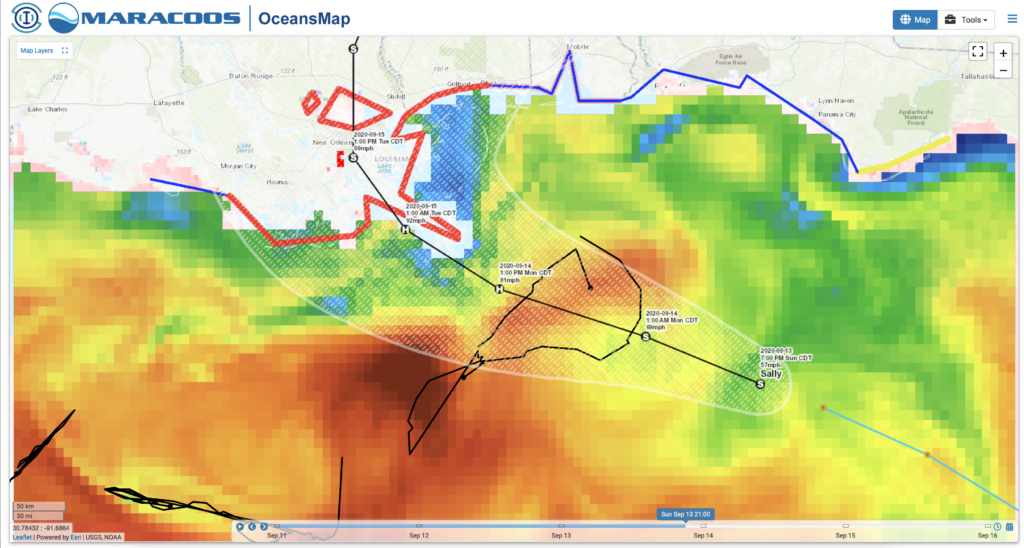
Sea Surface Temeperature from the Navy Global Ocean Forecasting System (GOFS) 3.1
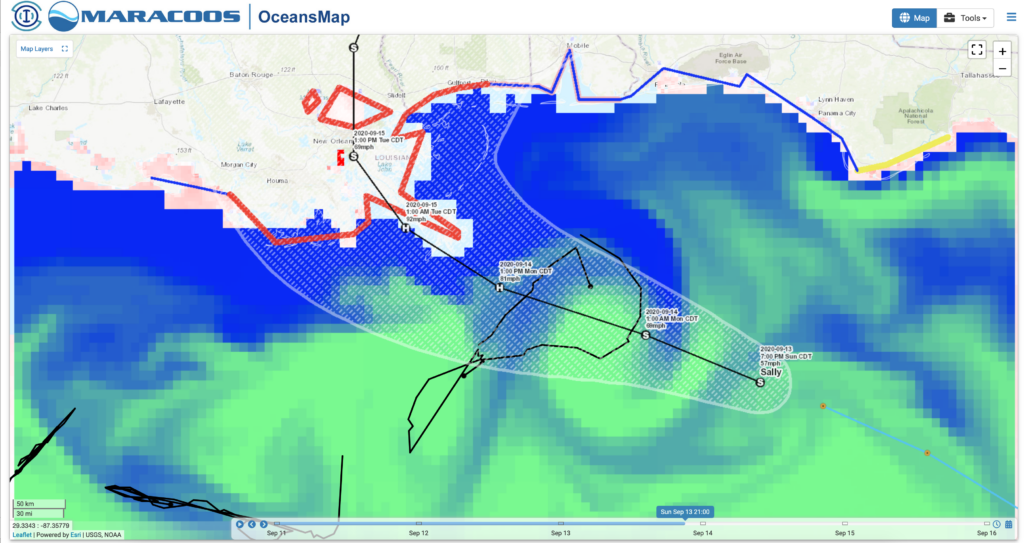
Sea Surface Salinity from the Navy GOFS model
Eddies like these can contain additional ocean heat that, if conditions are right, could be used as an energy source for the storm. We’ll be looking closely at SG601 data as it simultaneously enters the eddy, and starts to be influenced by the eye of the storm. Currently, profiles of temperature from SG601, show a warm surface layer over the upper 50 meters, that has not yet started to mix with underlying cooler waters.
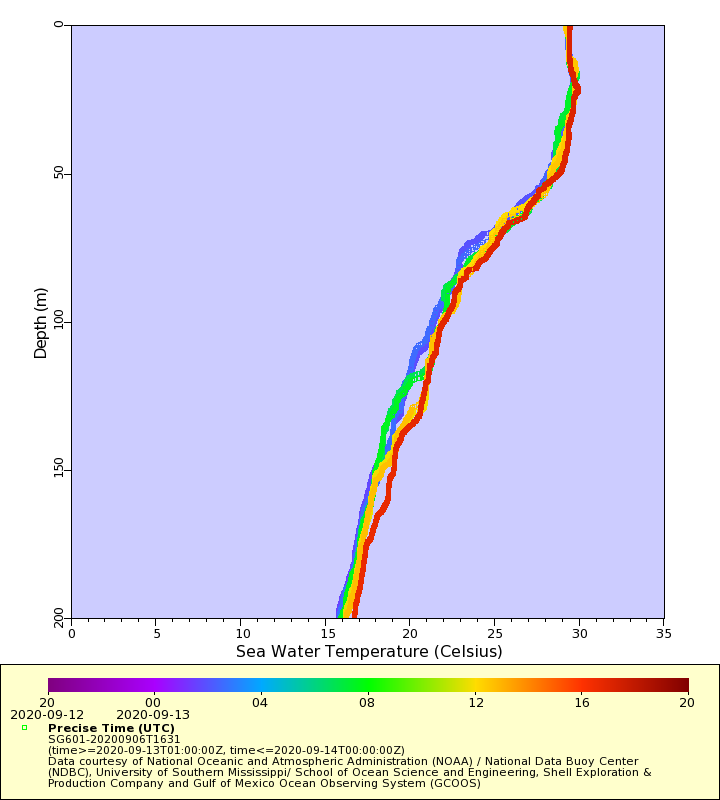
-
Coupled Modeling of Fay
Posted on July 12th, 2020 No commentsOver the last year a team at Rutgers has been developing new model coupling capabilities as part of the US IOOS Coastal Ocean Modeling Testbed (COMT) program. In this application we’ve coupled a regional ROMS model, DOPPIO, which covers the Mid-Atlantic Bight (MAB) and Gulf of Maine, and an implementation of the Weather Research and Forecasting (WRF) model. In this coupled system ROMS provides SST to WRF, while WRF calculates heat fluxes and passes back forcing information to ROMS.
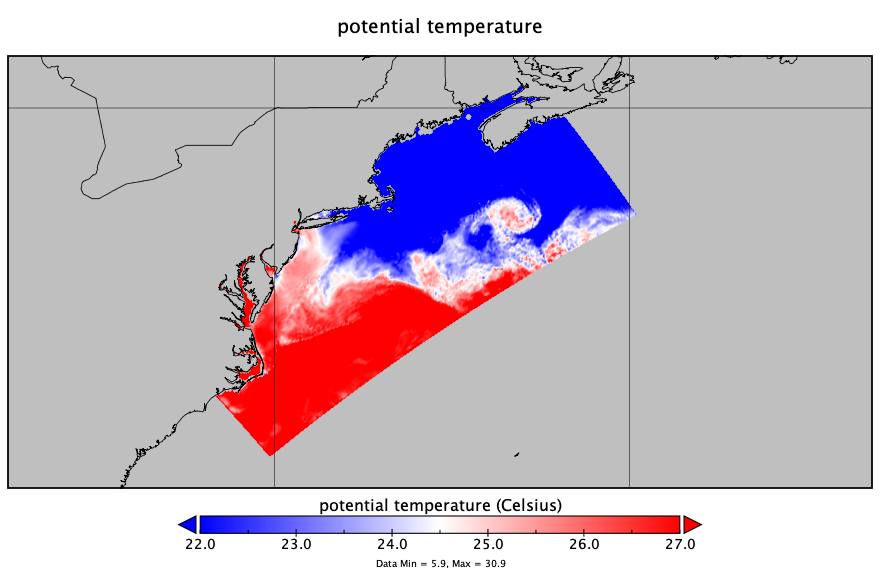
The coupled system was initialized on 07/09 00:00 GMT and ran forward 72 hours. In the first SST image from ROMS you can see warm surface waters over the southern portion of the MAB and cooler waters to the north and into the Gulf of Maine. As the storm passes the Atlantic Shores Buoy on 07/10 at 20:00 GMT the next SST image shows the cooling over the entire southern portion of the MAB.
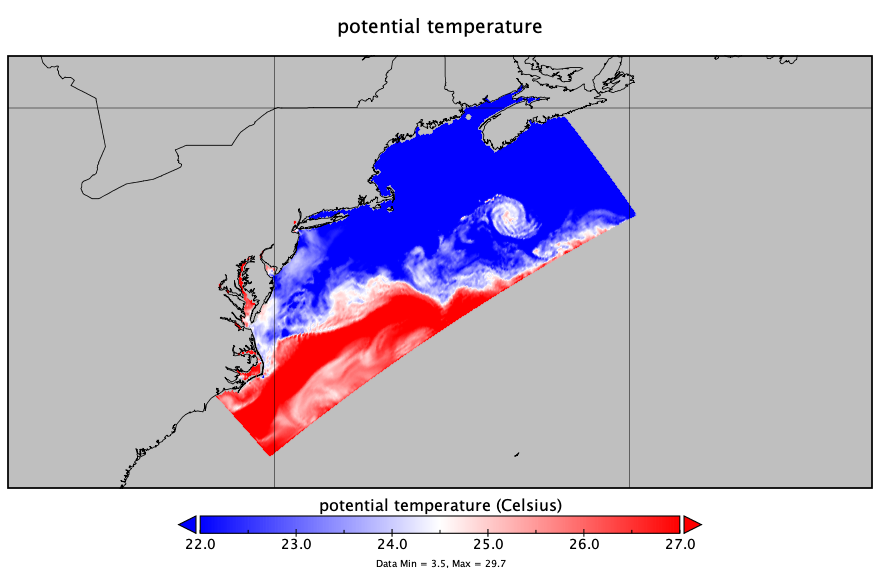
Animations of the latent and sensible heat fluxes from the WRF portion of the coupled model show that both heat fluxes were negative for much of the storm time period. This means that energy was getting sucked out of the atmosphere and into the ocean. This is setup from the cool ocean temperatures underneath a warmer atmosphere, just like we observed in the Hurricane Irene case back in 2011.
Over the next few weeks we’ll be evaluating how the model compares to the observations collected throughout the storm, and performing sensitivities to see how the ocean coupling influenced the storms intensity before landfall. More to come!
-
Michael Gulf of Mexico SST anomaly and ocean response
Posted on October 11th, 2018 No comments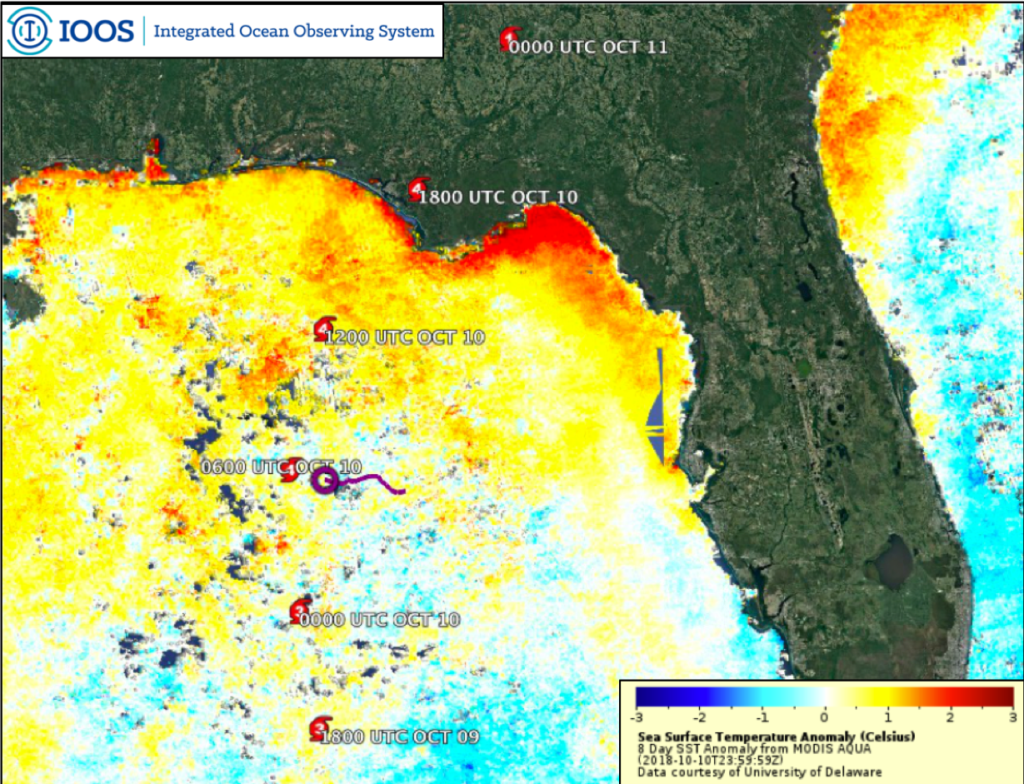
Micahel is now making its way through the Carolinas and into the Northeastern part of the country. It looks like it had a truly devastating impact of the Florida panhandle region coming ashore as a category 4, a few miles per hour shy of a category 5. Some of the rapid intensification is likely due to warm sea surface temperatures in the Gulf of Mexico. Above is a plot of the 8-day composite sea surface temperature anomaly after removal of the 15 year average for the same time period. This product is generated by the University of Delaware Ocean Remote sensing and Biogeography (ORB) Lab. Above average temperatures are clearly visible in the northern portion of the Gulf where the storm intensified.
Additionally, this image shows a glider track in purple for the US Navy Glider NG288, which we’ve been following for the past few blog posts. The system collected data throughout the storm, transmitted it to shore where the Navy made it available to IOOS for public release.
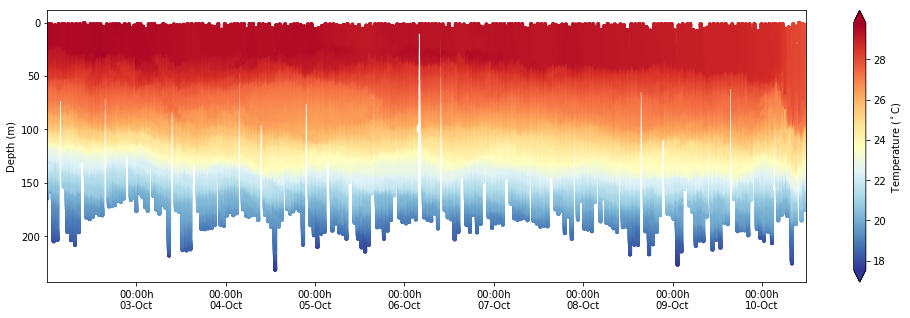
In the time and depth slice from NG288 it’s clear that surface layer was very warm, exceeding 28 Celsius down to about 50 meters ahead of the storm.This thick warm surface layer provided an ample pool of heat to maintain and intensify Michael as it approached land. On October 10th, as the storm passed over the glider location there is rapid mixing and deepening of the surface mixed layer from 50 meters down to almost 100 meters, but with very limited ocean cooling. This is an exciting dataset that we’ll be using for years to come to understand rapid intensification of hurricanes in the Gulf of Mexico.
-
Hurricane Michael glider model comparisons for October 9th
Posted on October 10th, 2018 No comments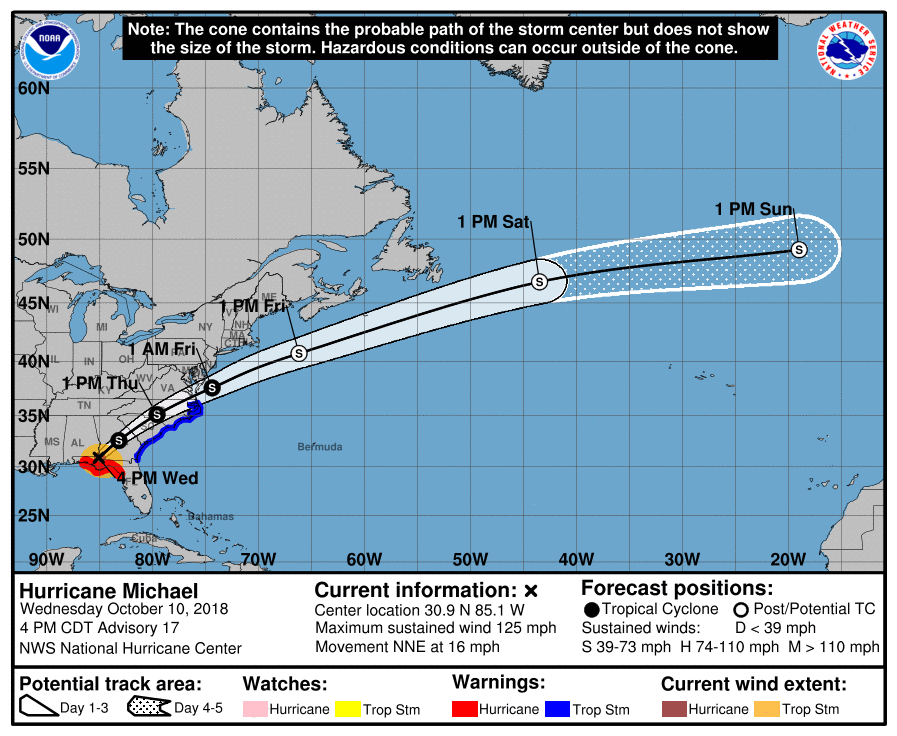
According to the National Hurricane Center Michael has made landfall in Florida as a Category 4 Hurricane with winds just below Category 5 levels.
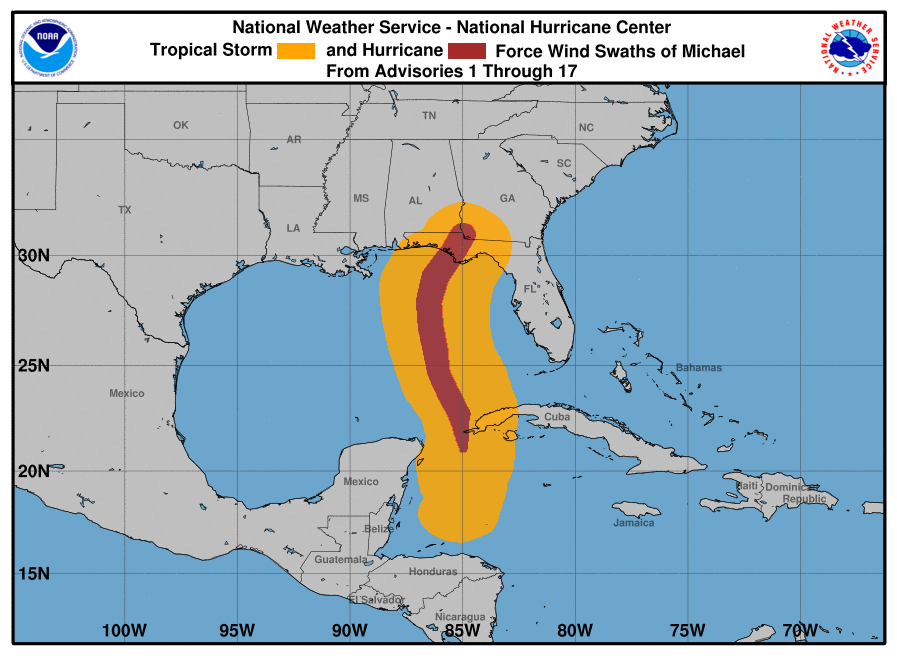
There’s an approximately 500 km wide swath of hurricane and tropical storm force winds across the eastern Gulf of Mexico.
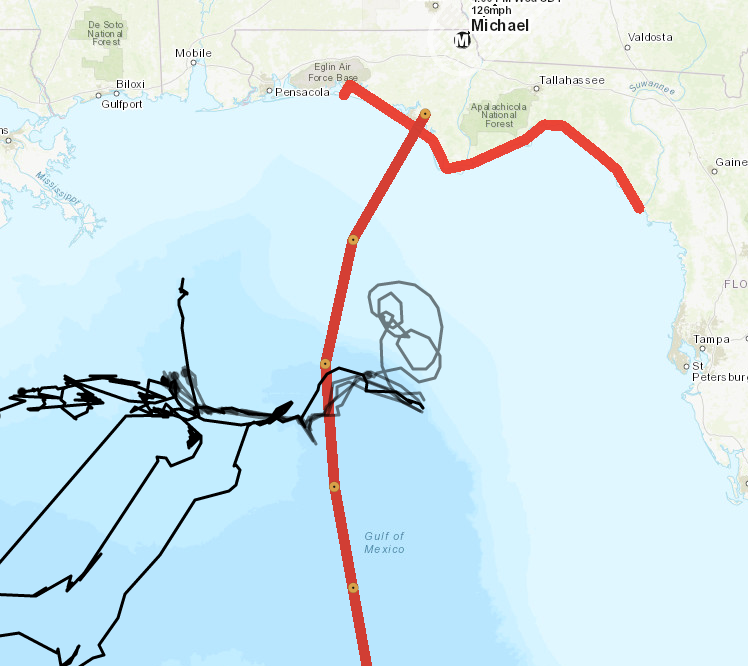
Just prior to landfall, the storm’s eye passed within about 50 kilometers of Navy Glider NG288’s most recent reported location.
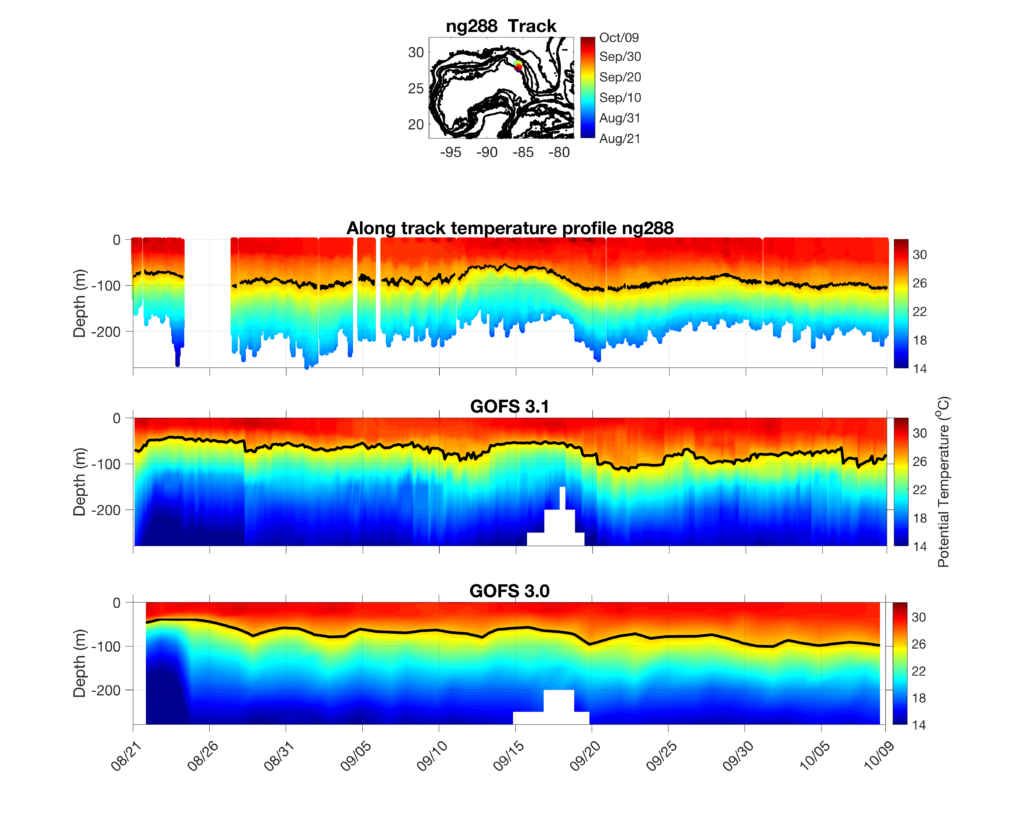
Above are Cross-sections of temperature from (top) Glider NG288, (middle) the Navy HYCOM Global Ocean Forecasting System 3.1, and (bottom) Navy HYCOM Global Ocean Forecasting System 3.0 run by the Navy Research Laboratory. The black contour shows the position of the 26 degrees Celsius isotherm, which is commonly used to calculate ocean heat content for hurricane intensity purposes.
At a glance the models have similar surface temperatures to the glider observations throughout the deployment, but the 26 degree Celsius isotherm in both GOFS 3.0 and 3.1 appear to be slightly shallower than the observed position.
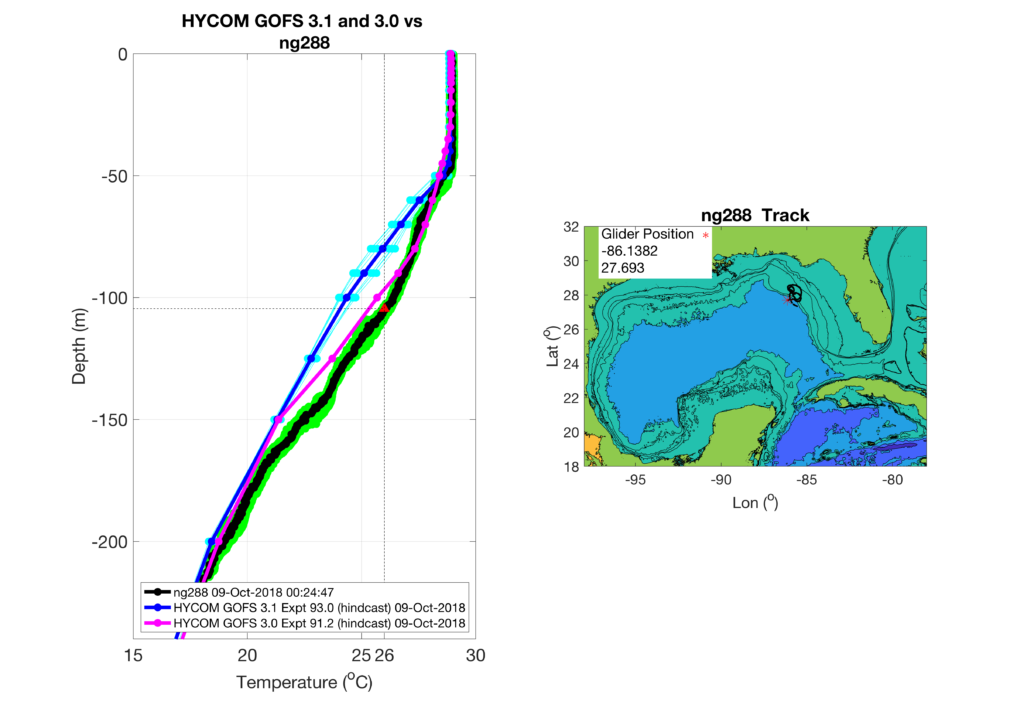
Next we zoom in to the last days profile comparisons before Michaels passage. The lines and colors are defined as in the previous post, but now we’ve added a vertical line and red triangle indicating the 26 degree Celisus temperature its depth in the glider observations. The depth of the mixed layer at 50 meters is well represented by GOFS 3.1, while GOFS 3.0 does a better job of matching the observed temperature profiles below the mixed layer.
-
Navy Glider Model Comparisons for Hurricane Michael
Posted on October 8th, 2018 No comments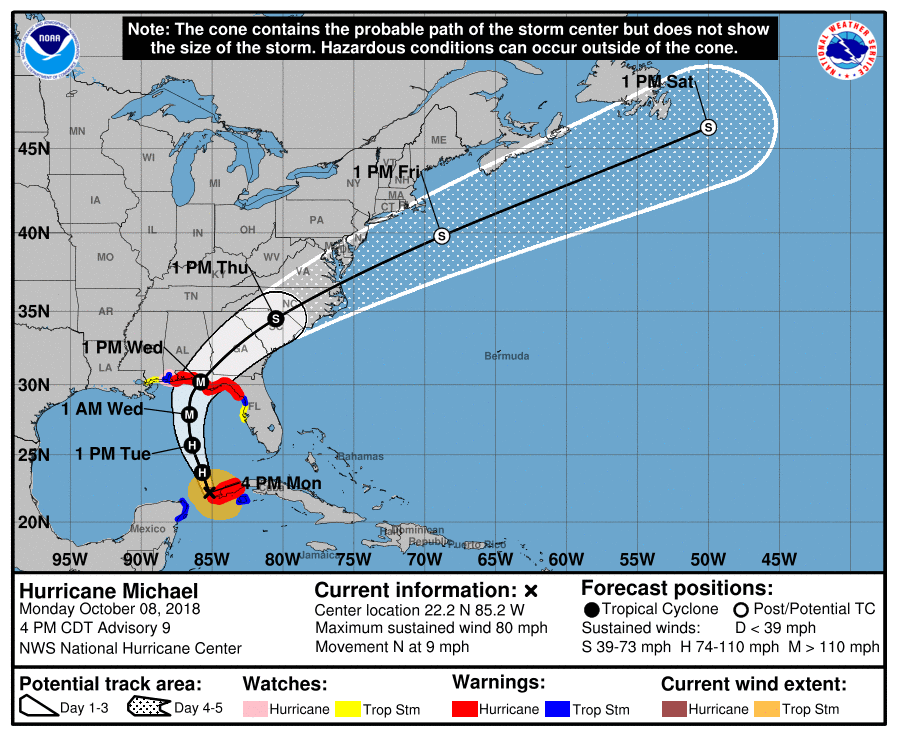
The Atlantic Hurricane season is not over yet. Hurricane Michael has recently spun up in the Caribbean Sea and is making its way into the Gulf of Mexico. There are still a number of gliders in the east coast, Caribbean, and Gulf of Mexico picket line out there. Navy Glider NG288 is positioned just to the right of Michael’s predicted track, where winds, waves, and ocean mixing are likely to be the highest. A plot of the NHC storm track and glider track (in black) is shown below from the MARACOOS Oceansmap Data Portal
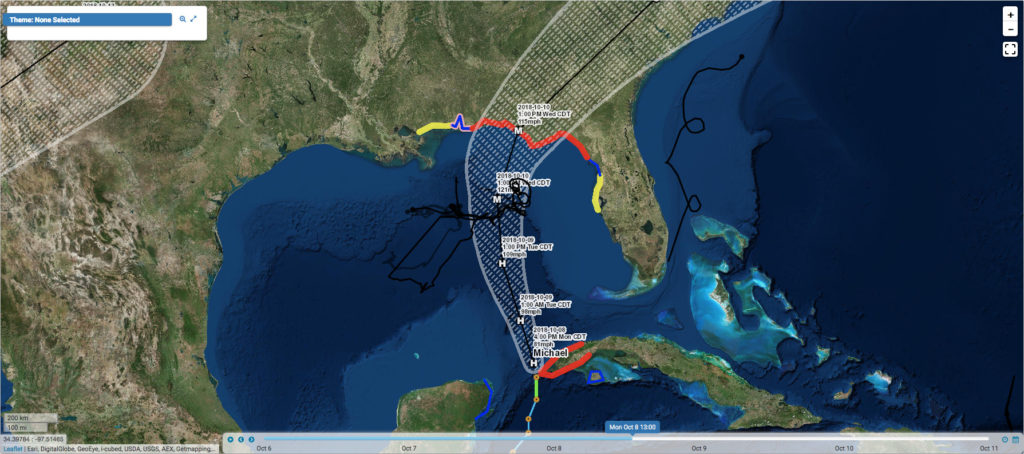
Maria, our IOOS research analyst, has generated the usual glider data/model comparison profiles for the last day from Navy HYCOM GOFS 3.0 and 3.1.
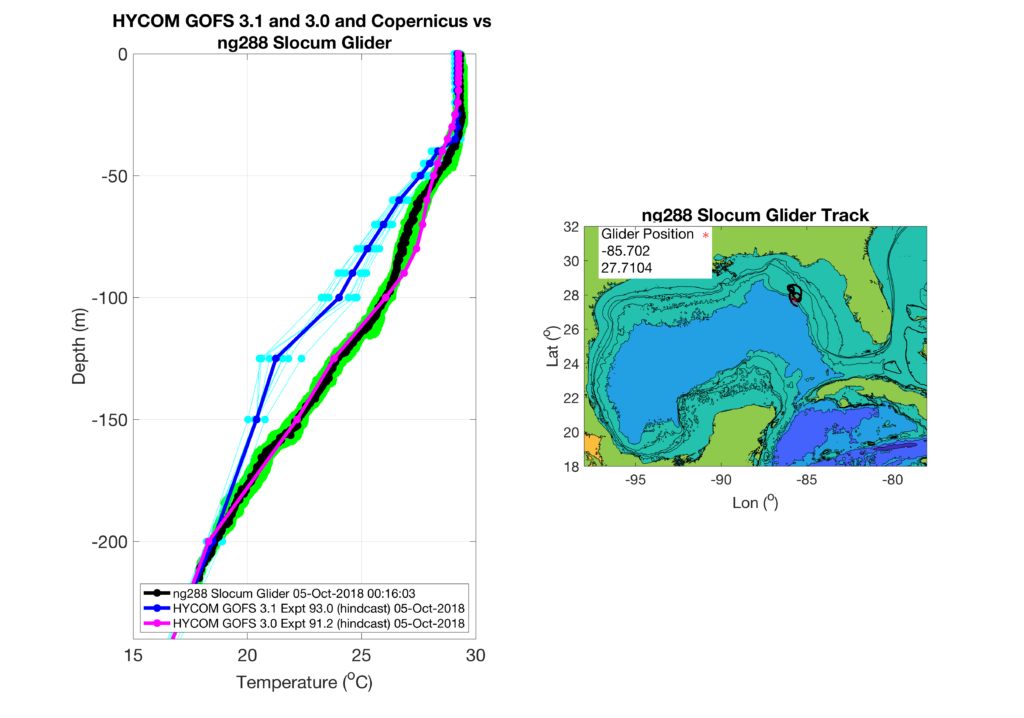
In the left panel: individual glider data profiles are shown in green with the daily mean in black, GOFS 3.0 only archives daily and is plotted in magenta, and GOFS 3.1 profiles are every 3 hours and plotted in light blue with the daily average in dark blue. In the upper 30 meters both GOFS 3.0 and 3.1 are in good agreement with glider observations with temperatures all near 29 Celsius. Below 30 meters depth the models diverge, with GOFS 3.0 following the glider profiles closely throughout the water column. GOFS 3.1 remains a few degrees cooler than the glider and 3.0 until about 200 meters depth. The heat content, defined as the depth integrated heat above the 26 degree isotherm, for GOFS 3.1 is going to be lower than the glider or GOFS 3.0.
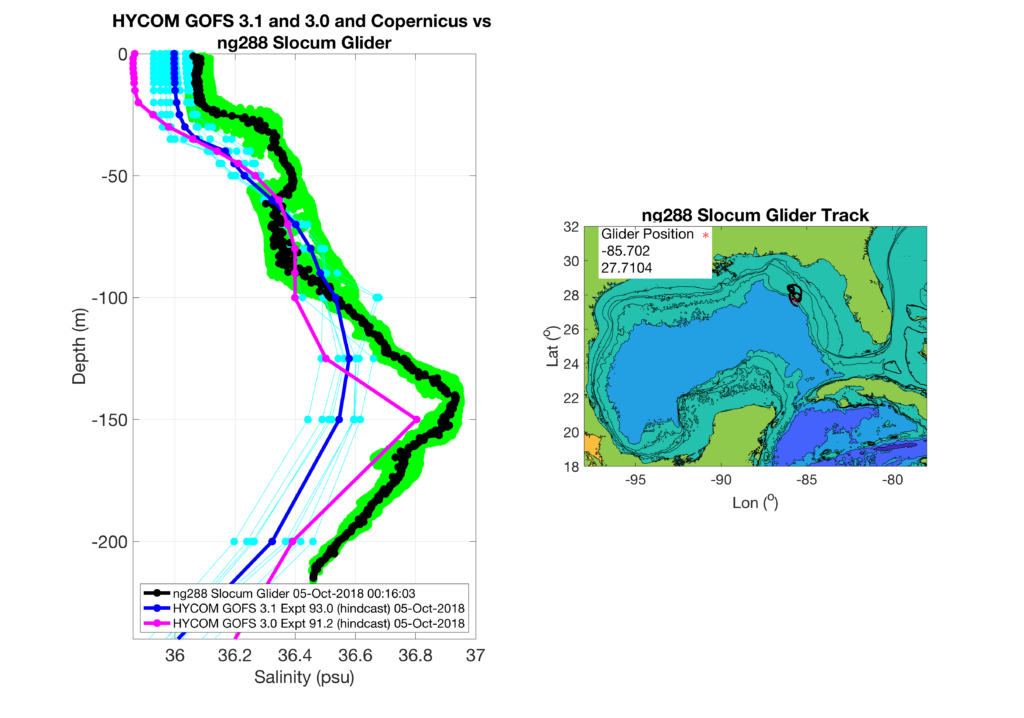
Both models are fresher than the observed salinity profiles throughout the water column, with GOFS 3.1 being closer to observations in the surface, and GOFS 3.0 closer near the salinity maximum at ~150 meters depth.
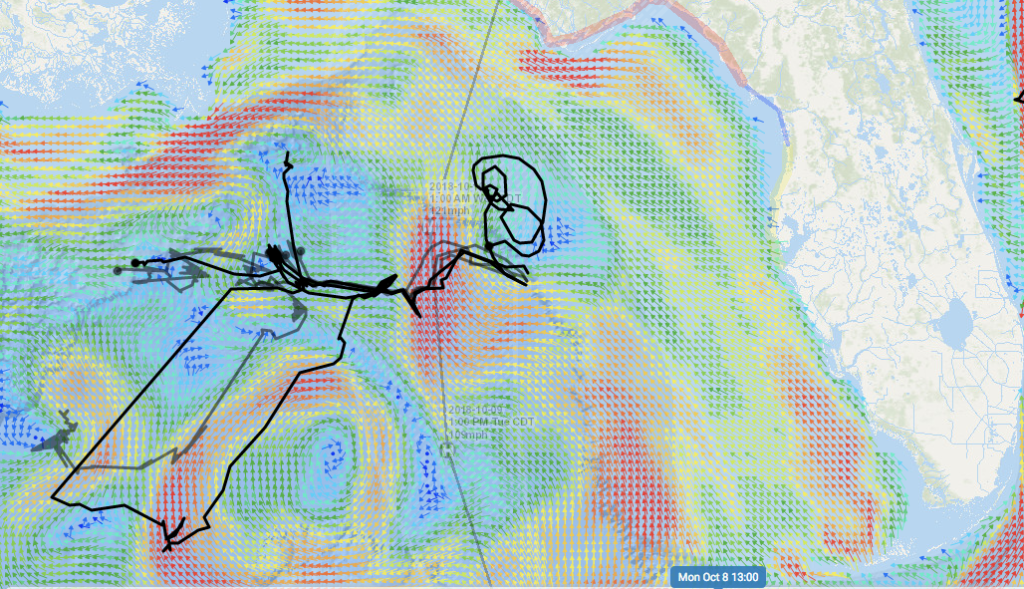
A snapshot of surface currents from Navy HYCOM in MARACOOS Oceansmap shows that a warm core loop current eddy is located just to the west of the storms predicted position at 1:00 PM CDT Tuesday October 9th. The glider is located in a frontal region near the storms predicted position at 1:00 AM CDT Wednesday October 10th, with slow currents to its east and fast northward currents to its west. The uncertainty in model data comparisons may be related to the placement of these features in the different models, and will require further investigation.
-
Isothermal shelf waters and Florence
Posted on September 14th, 2018 No commentsFlorence is approaching Wilmington NC as a category 1 storm according to the National Hurricane Center https://www.nhc.noaa.gov/text/refresh/MIATCDAT1+shtml/140842.shtml
It’s slowed down significantly and is still sitting over warm coastal ocean waters. Glider data profiles from RAMSES to the north of Florence and PELAGIA to the south of Florence in previous posts have shown that the continental shelf of the South Atlantic Bight is isothermal, or uniformly warm from top to bottom. Additionally, with the approach angle of Florence winds look to be downwelling favorable meaning that any cold bottom water on the outer shelf was or is likely being advected offshore, while warm surface water is potentially being advected onshore.
This means that despite vigorous mixing in the coastal ocean there is not likely to be any ocean cooling on the shelf, as there simply isn’t any cold water available to mix to the surface. Bottom temperatures from the European Mercator model show warm bottom temperatures across the entire SAB in contrast to the cold bottom temperatures in the MAB.
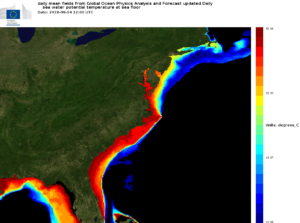
Florence has been a slow moving storm over the continental shelf and with little ocean cooling these warm waters will likely not help weaken the storm.
A new batch of glider profiles are coming in this morning to confirm this, but overall this highlights the large differences in regional coastal ocean water masses and highlights processes that we’ll want to investigate in the coming years to better understand how coastal oceans affect storm intensity ahead of landfall.
-
September 10th Glider RU33 GOFS 3.1 and GOFS 3.0 Comparisons
Posted on September 10th, 2018 No commentsComparisons for RU33 in the MAB show that both GOFS 3.1 and GOFS 3.0 are over predicting sea surface temperature.
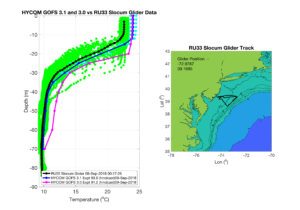
We’ll shortly be adding comparisons to additional gliders deployed throughout the eastern US and Caribbean.
Travis



